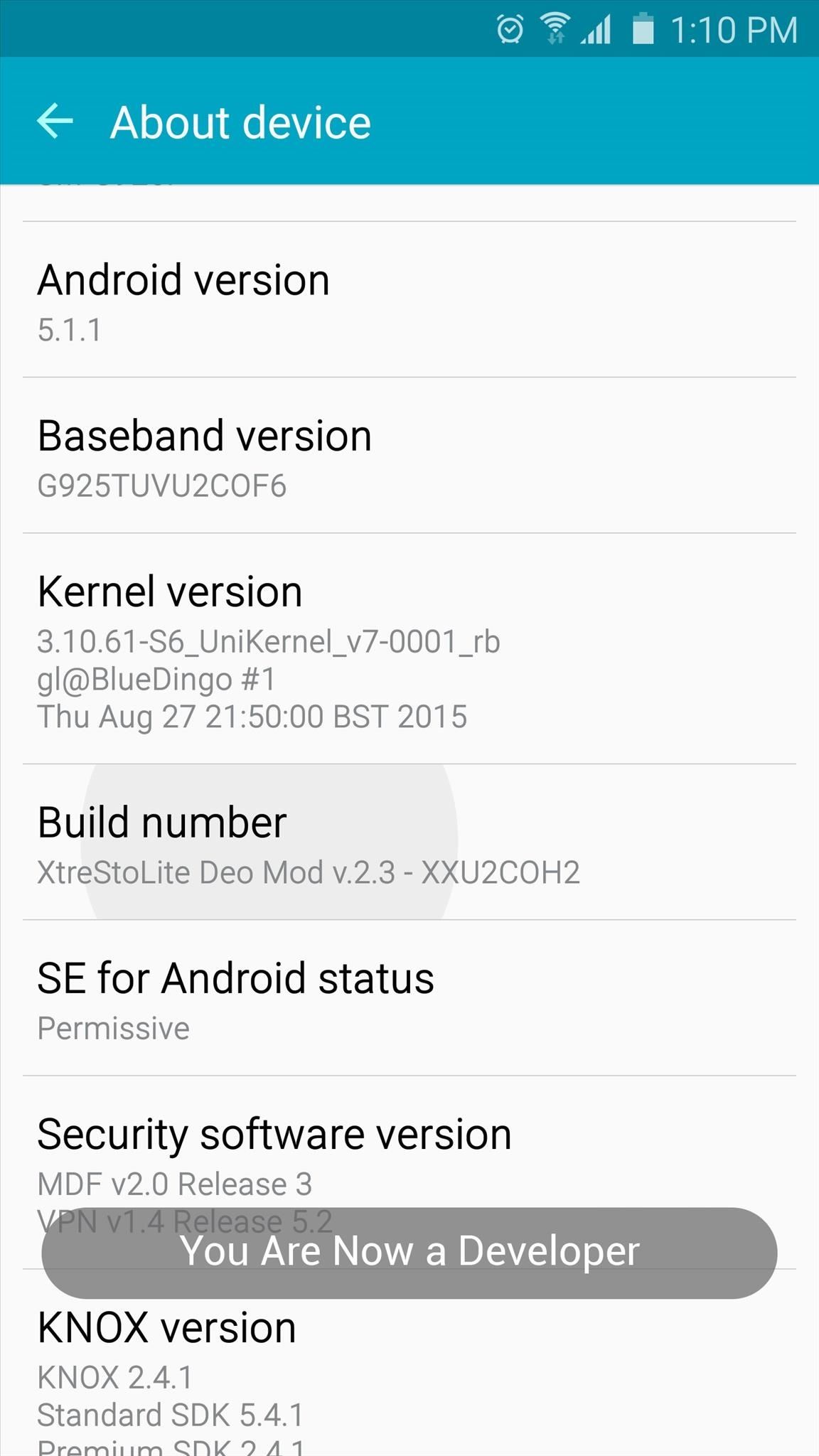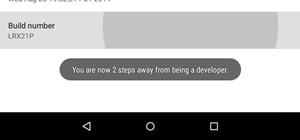Reasons to Unlock Developer Options on Yon case you didn't know, Android has an awesome hidden settings menu called "Developer options" that contains a lot of advanced and unique features. If you've ever come across this menu before, chances are you just dipped in for a minute so that you could enable USB debugging and use ADB featuBut there are plenty of other cool things you can do with this menu, it's just that most entries aren't exactly labeled in plain English, so they're not very easy to discover. In an effort to curb all of that, I'll show you some of the most interesting Developer options settings
In order to access any of these cool options, you'll first need to unlock the hidden Developer options menu on your device. To begin, head to the main Settings menu, then select About phone, About tablet, or About device. From here, tap the "Build number" entry 7 times in rapid succession, and you'll get a toast message informing you that the Developer options menu has been unlocked.
From here, just back out to the main Settings menu again, and you'll find the new "Developer options" entry near the bottom, so go ahead and select it.
#1Process Stats
The first interesting Developer options entry we have for you is called "Process stats." When you tap this one, you'll see an interface that's very similar to Android's battery menu—except this one gives you details about your device's RAM memory usage. The bar graph at the top of the screen tells you what percentage of RAM is currently in use, and the app listings beneath it are ordered by how much memory each app is currently using.
If you tap the bar graph, you'll see the amount of time your RAM usage has been reported as "Normal" or otherwise, and beneath that, you can see the types of processes that have been using your memory. On the other hand, if you tap an app listing from the main Process stats menu, you'll see details about the app's RAM usage, with a button that lets you easily force stop a RAM-hungry app.
#2Force RTL Layout
This next cool Developer option is mostly just a fun way to experience your phone in a new layout—though if your system language is set to Arabic, Urdu, or Yiddish, for example, it can be quite helpful, as well as if you're left-handed.
Toggle the switch next to "Force RTL layout," and the orientation of almost all elements on your screen will switch over to an RTL, or right-to-left, layout. Text formatting will still be defined by your regular system language, so you can still read everything, but the formatting might be a better fit for certain languages.
#3Window & Transition Animation Scale
The next entry in our list is actually a set of two options that let you adjust the speed of transition animations. "Window animation scale" affects transitions that occur within apps (such as popups, for example), and "Transition animation scale" deals with the animations that take place when you're switching between apps. A third similar option, "Animator duration scale," only affects certain loading animations, so we'll skip over that one.
If you'd like to speed up the animations, set these options to a value lower than 1x, and almost magically, your phone will instantly feel a lot snappier. On the other hand, if you'd like to see the animations in slow motion, set the values to a higher number.
#4Force GPU Rendering
This next option might help if you're experiencing graphical sluggishness in some apps. As of version 4.0, Android now uses your device's dedicated graphics processor to render two-dimensional objects by default. Some apps, however, haven't been updated to take advantage of this faster method of rendering graphics.
So if you have any apps whose graphics seem to be rendering slower than the rest of your apps, enable the "Force GPU rendering" option. This will make sure that all apps take advantage of Android's hardware acceleration feature, which should make the user experience a lot smoother in some cases.
#5Show CPU Usage
This next option will come in handy if you've ever wondered what was going on behind the scenes on your Android device. Enable the "Show CPU usage" toggle, then you'll instantly see an overlay on your screen that shows you all of the processes that are currently running. These entries are ordered by their current CPU load, and your overall processor usage is shown as a bar graph at the top of the screen.
#6GPU Rendering Profile
If you'd like to test your device's graphics performance, select the "GPU rendering profile" option and set it to "Show on screen as bars." This can be a very useful way of comparing the graphics performance for different apps on your system, since the overlay will be shown on top of all screens.
The condensed graph at the top of your screen shows recent graphics performance history, while the bars across the bottom of your screen depict graphics performance on the fly. Higher spikes mean there was a heavy GPU load at that moment, so in general, this is a great way to see if an app is dropping frames or performing poorly from a graphics standpoint.
#7Background Process Limit
If your "Process stats" menu was looking abysmal earlier, or if your phone just doesn't have much RAM, you might want to look into this last option. Select "Limit background processes," then you can choose the amount of processes that are allowed to run in the background and eat up memory on your device. For instance, you can set this to "2 processes at most," then only the current app and the two most recent background processes will be allowed to run, which should free up a lot of memory on your device.
Which of these cool Developer options entries is your favorite? Let us know in the comment section below, or drop us a line in the comments
Credit :Android Hacks































